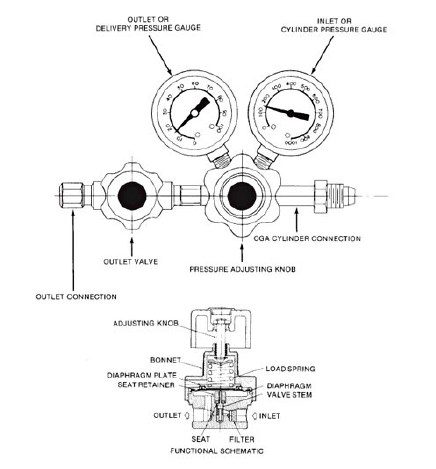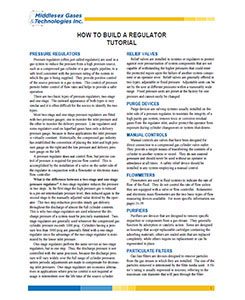Specialty Gases & Equipment - How to Build a Regulator

Pressure Regulators
Pressure regulators (often just called regulators) are used in a gas system to reduce the pressure from a high pressure source, such as a compressed gas cylinder or a gas supply pipeline, to a safe level consistent with the pressure rating of the system to which the gas is being supplied. They provide positive control of the source pressure in a gas system. This control of pressure permits better control of flow rates and helps to provide a safer operation.
There are two basic types of pressure regulators; two-stage and one-stage. The outward appearance of both types is very similar and it is often difficult for the novice to identify the two types.
Most two-stage and one-stage pressure regulators are fitted with two pressure gauges; one to monitor the inlet pressure and the other to monitor the delivery pressure. Line regulators and some regulators used on liquefied gases have only a delivery pressure gauge, because in these applications the inlet pressure is virtually constant. Historically, the compressed gas industry has established the convention of placing the inlet and high pressure gauge on the right and the low pressure and delivery pressure gauge on the left.
A pressure regulator does not control flow, but precise control of pressure is required for precise flow control. This is accomplished by the installation of a valve on the outlet side of the regulator in conjunction with a flowmeter or electronic mass flow controller.
What is the difference between a two-stage and one-stage pressure regulator? A two-stage regulator reduces the pressure in two steps. In the first stage the high pressure gas is reduced to a pre-set intermediate pressure level, then reduced again in the second stage to the manually adjusted value desired by the operator. This two step reduction provides steady gas delivery throughout the discharge of almost the full cylinder contents. This is why two-stage regulators are used whenever the discharge pressure of a system must be precisely maintained. Two-stage regulators are generally used whenever the compressed gas cylinder pressure exceeds 1000 psig. Cylinders having a pressure less than 1000 psig are generally fitted with a one-stage regulator since the advantage of the two-stage regulator is minimized by the lower inlet pressure.
One-stage regulators perform the same service as two-stage regulators, but in one step. Thus, the discharge pressure is not controlled with the same precision, because the discharge pressure will vary widely over the full range of cylinder pressures unless periodic adjustments are made to compensate for decreasing inlet pressures. One-stage regulators are economic alterna-tives in applications where precise control is not required or usage is intermittent over the life time of the source cylinder.
Relief Valves
Relief valves are installed in systems or regulators to protect against over pressurization of system components that are not capable of withstanding the higher pressures that could enter the protected region upon the failure of another system component or an operator error. Relief valves are generally offered in two types, adjustable or fixed pressure. Adjustable units can be set by the user at different pressures within a reasonably wide range. Fixed pressure units are preset at the factory for one pressure and cannot easily be changed.
Purge Devices
Purge devices are valving systems usually installed on the inlet side of a pressure regulator, to maintain the integrity of a high purity gas system, remove toxic or corrosive residual gases from the regulator inlet, and/or protect the operator from exposure during cylinder changeovers or system shut-downs.
Manual Controls
Manual controls are valves that have been designed for direct connection to a compressed gas cylinder valve outlet. They provide a simple means of transferring the contents of a cylinder to another system or vessel. They do not control pressure and should never be used without an operator in attendance at all times. A safety relief device should be installed in any system employing a manual control.
Flow Meters
Flowmeters are used in fluid systems to indicate the rate of flow of the fluid. They do not control the rate of flow unless they are equipped with a valve or flow controller. Rotameters and electronic mass flowmeters are the two basic types of flow measuring devices available.
Purifiers
Purifiers are devices that are designed to remove specific impurities or components from a gas stream. They generally function by adsorption or catalytic action. Some are designed as housings that accept replaceable cartridges containing the adsorbing materials, others are sealed units that are replaced completely, while others require no replacement or can be regenerated in place.
Particulate Filters
Gas line filters are devices designed to remove particles from the gas stream in which they are installed. The size of the particles removed is determined by the filter media used. A filter’s rating is usually expressed in microns, referring to the maximum size diameter that will pass through the filter.
Valves
There are two basic types of valves used with gases; diaphragm packless and packed. Diaphragm, packless valves are used for on/off control or rough flow control in high purity applications. They are designed using a metal diaphragm to seal the gas cavity from the valve stem threads. Packed valves are designed with a packing gland that creates a seal on the valve stem. This packing may be above or below the threads of the valve, depending on the intended application.
Cylinder Scales
A cylinder scale is used to monitor the contents of a liquefied gas cylinder feeding a critical batch operation where a lack of gas during the run would cause the batch to fail. Cylinder scales are designed to provide a positive indication of the amount of product remaining in the cylinder. Two types are generally offered, mechanical and electronic. Electronic scales offer the added benefit of a low weight alarm and relay contacts to operate accessory equipment. Both types are offered in this catalog.

